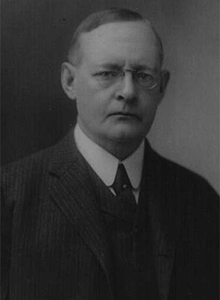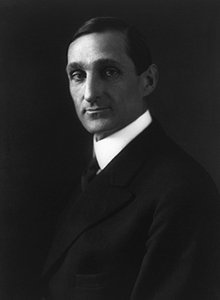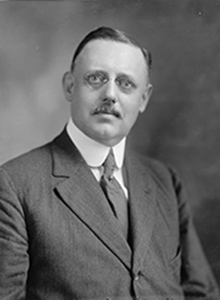
Charles S. Hamlin
- Member, Federal Reserve Board, 1916 – 1936
- Governor, Federal Reserve Board, 1914 – 1916
- Born: August 30, 1861
- Died: April 24, 1938
Charles S. Hamlin was the first governor to lead the Federal Reserve Board.1 He took office on August 10, 1914, and was governor until August 9, 1916, then remained on the Board as a member until February 1936. He continued to serve the Board as special counsel until his death on April 24, 1938.
Hamlin was born in Boston in 1861. He received his bachelor's degree, master's degree, and bachelor of laws from Harvard University in 1886. He received two honorary doctor of laws degrees from Washington and Lee University (1895) and Columbia University (1938).
Hamlin began his professional career as a lawyer. He practiced in Boston from 1886 to 1893 and also from 1898 to 1913. He was appointed assistant secretary of the Treasury twice, serving from 1893 to 1897 and from 1913 to 1914. At the suggestion of Hamlin's boss, Treasury Secretary William McAdoo, President Woodrow Wilson appointed him to lead the first Federal Reserve Board.
Although many historians do not consider him to have been a dynamic executive, Hamlin proved himself a diplomat through his skillful handling of the power struggles and political differences of the new agency. He also shaped the organizational structure needed to help the Board accomplish its mission under the Federal Reserve Act. However, under the original Act, the Treasury secretary was ex officio chairman and presided over meetings of the Board. This essentially relegated the person appointed governor to a subordinate role. In addition, the Board under Hamlin took a rather passive approach to policymaking, allowing Treasury to dictate policy matters of the era.
Throughout his lifetime, Hamlin was involved with many government and civic organizations. In 1897, he was a special commissioner of the United States to Japan; a special commissioner at a convention among Russia, Japan, and the United States to negotiate a dispute over fur-seal fishery; and the chairman at a seal conference between Great Britain and the United States. In 1898, he was a member of the board of the Paris Exposition Commissioners from Massachusetts. He served as member of the executive committee at the Indianapolis Monetary Commission in 1899.
At Harvard University, Hamlin was a lecturer on the US government from 1902 to 1903 and was a member of the Committee on Government from 1906 to 1915. He was a delegate to the Democratic National Convention in 1904. In 1910, he was unanimously nominated for Congress, but declined the honor.
In 1903, Hamlin was a member of the US Assay Commission to examine the Philadelphia Mint. He was a member of the Japanese Famine Relief Committee in 1906 and in 1908 was decorated by the emperor for his service. Hamlin also served on the US Committee on Limitation of Armaments in 1908
From 1907 to 1912, Hamlin was an arbitrator for industrial disputes involving Boston companies and unions. He was also a delegate to the Fisheries Conference called by New England governors in 1908. In addition, he was a trustee at the Carnegie Endowment for International Peace and a long-standing member of the National Grange.
Hamlin's papers, including his extensive diaries, are housed in the Library of Congress Manuscript Division.
Endnotes
- 1 Governor was the title of the “active executive officer” of the Federal Reserve Board from 1913 to 1935. See the Board of Governors website and the essay on the Banking Act of 1935 for details on changes in the Board’s leadership structure over time.
Written by the Board of Governors of the Federal Reserve System and updated on October 14, 2025 by Federal Reserve History staff to clarify the historic titles used before 1935. See disclaimer and update policy.



 X
X  facebook
facebook
 email
email